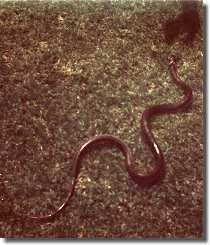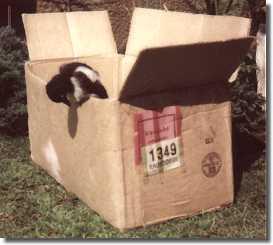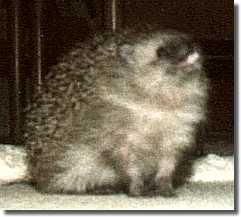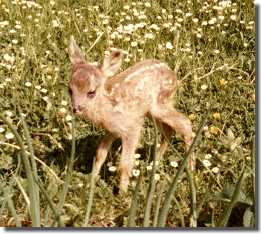
WP's: HOME |
[Animal
Farm]: Cats'
Farm ~ Farm Extension | ?Help? | Deutsch 
(Not to confuse with that of George
Orwell.
By the way, the button image shows »Die Bremer Stadtmusikanten«
(Engl.: The Town Musicians of Bremen, donkey, dog, cat and
rooster), a German fairy tale)

Not a rattle, but a ring snake
Environment close to nature in the outskirts' garden
offers numerous species a hiding place and a place for living. The
sunny and sandy south-west incline is appreciated by lizards, which
are very easy to tame. One can feed them with flies and worms hold
between the fingers. On hot days the thankfully accept water. Where
lizards live slow-worms aren't far.
Even »exotics« show up. For instance cross-vipers, black
woodpeckers or at the winter feeding even ten(!) pheasants at a
time.
A view with the binoculars through the window often is much more
interesting than watching TV.
Thanks to water biotopes in the neighborhood there are ring-snakes
(refer to image; clearly the yellow half moon marks on the sides of
the head are to be seen), grass and water frogs, toads.
For some years a pair of grass frogs stayed in the garden. With
hardly more than one meter distance between them. On hot days they
seek cooling in the bird bath and it was almost possible to touch
them.
Additionally various dragon fly species bustle here and in general
insects and other small animals over all.
Exciting was when hornets had chosen a bird nesting box for their
own nest and to see it grow. Opposite common prejudice they are
rather harmless and facile.
Extra animal stories from the nearer wild - Farm
Extension:
MORE
Have you ever tried to feed a spider by hand? I made a funnel
web spider take mosquitoes clamped between my fingers and even left
its net in order to accept flies presented on my hand. Some
spectators turned very pale by that...
Also it is great to watch the brood care of the daddy-long-legs
spider (vibrating spider). The mother spider watches over the egg
cocoon and later over the baby spiders for some days. When one puts
a prey animal in the net, the spider very carefully steps across
over its babies. Once the young spiders had chosen a fluorescent
tube for a first rest. Whenever it turned warm they side by side in
dozens roped down an appropriate distance. It looked like a hazy
shade of curtain. When after switching off the lamp turned colder
they climbed up stepwise again.
Of course, all the culture followers like mice, blackbird, magpie,
jay, squirrel, titmice (6 species), woodpeckers and robins are well
represented. Especially the last get very friendly. Well, the young
titmice now and then land on one's hand waiting for feed.
Previously the adult birds don't appreciate one standing near the
nest box. But keeping away squirrels one's nearness is made use of
as protection and they immediately fly in.
And with the great spotted woodpeckers it's another matter. I can
remember those times they hastily left the garden, when one just
moved behind a window. Nowadays one clears the path of snow in less
than two meters distance a woodpecker clambers crying about a tree:
Bird fat balls are out! Hardly one has mounted a ball and just
turning away immediately a woodpecker clings at it. Nuthatch and
treeceepers are guests, too.
The animals are used to humans more or less. One get on with each
other or one simply keeps out of others' ways.
Everything and all for nothing but the
cat:
MORE
Even now and then the scientific curiosity or the
helpfulness demand more. Then deeper contact takes place. Who does
not want to thoroughly watch the metamorphosis of frogs? Or who
wants to let perish a helpless animal baby?
That enables the deeper concerns about the individual behavior and
the nuanced interactions with humans. Thereby it just scratches a
bit the rather mechanistic approach of the behavioral
biology.
Not to mention the real domestic animals or pets.
Real love for animals: During the bicycle tour discovering a puddle with tadpoles just before drying up and saving them in the drinking water bottle. Or even like my aunt: cycling home, returning with the camper and filling up the puddle out of the drinking water reservoir.

They are off their rocker...
Entering as foundling brought by a friend, the magpie
chick was called Hansi. (It is not unusual that young magpies leave
the nest although they are not yet fledged. In general they are
fed by the adult birds further on.) He showed very great shyness
concerning people and tried to flee. Although he was obviously
exhausted he refused any food offered. Even water wasn't
accepted.
Not until I spent some time, used tricks and cunning and a little
bit force as well, I was able to stuff a small ball of minced meat
into his throat and force him to swallow. But then Hansi accepted
the second piece voluntary and asked for more.
After that he was allowed to make himself comfortably on the
backrest of a kitchen chair and surprised us because he started to
turn restlessly under crying, better whining - hazels are
house-trained! Thankfully he accepted an offered piece of newspaper
and then fell asleep.
Hansi was allowed to move by his own choice and slept on a
backrest of a kitchen chair. In the house or in the garden he ran
after one. The most popular game was »turning stones«. I rolled
over stones in order to find adequate nourishment. Hansi had great
fun. Even when he obviously had no more hunger, he curiously checked
the base of every stone I turned.
He showed no urge to fly as if he didn't know he would be able to
do it. Even if he should have been full-fledged. Not until I softly
threw him in the air he started to flutter. First he had sought
refuge in the trees higher and higher and spent moaning the whole
night there. On the next morning he tried to directly hit the open
kitchen window in the second floor. Too high! Out of the roof gutter
he managed to get back to the trees. Second trial: Too deep! Again
back in another roof gutter to the trees. Not until I came back from
school he took heart. From limb to limb and tree to tree he made
his way downstairs and touched down in the lawn with a somersault
after slithering over a sun umbrella, but he was in fear of
punishment. After he calmed himself down and had eaten and drunk
for three days he felt asleep for a complete day.
Even so when he learned to fly he stayed with us on his own
decision. He slept on a clothesline in the cellar where a window
provided access. In the morning he sat on the windowsill of the
kitchen on the first floor waiting that somebody let him in for
breakfast. Then he followed his people to the car, to school, to
the shopping tour, ... He landed on one's shoulder on demand.
Imagine that: suddenly a big black and white bird dives from the
sky stopping in last moment to land soft like a feather on one's
shoulder. Witnesses were upset.
During the day he strolled through the house and the garden. In
the evening he »told« sitting on one's shoulder, what had happened
during the day.
The play instinct was very strong. He liked to fill sleeping
grandpa's ears with gleaming pebbles. In the house he was a fan of
glittering paper of sweets. First he watched me snipping it from
the table, then he flew with it on a cupboard and let it glide to
the ground. The only thing he theft was father's pipe stopper made
of shiny metal. All other valuable and shiny things we kept away
from him.
Indoor he seldom flew, but when then impressive. Usually magpies
are not considered as good flyers, however, when he poised on the
spot or even backwards(!) like a hummingbird one couldn't believe
it.
His social behavior was striking. Thereby an inhibition existed.
Never he etched closer with his beak pointing towards one's face or
even eyes. Within a certain distance he was forced to turn his head
to the side. (Well, therefore the proverb: »A crow does not
pick one others' eyes.«) He, however, insisted to examine my
teeth - starting with carefully scrapping to fierce knocking. He
seemed to be deeply impressed.
And sometime I risked at least one eye when he intended to
practice social body care: Obviously the aesthetic feeling of
magpies and human beings is not very different. He just pulled out
the hairs in my nose. Spreading hears of my eyebrow he bent in form
with tongue and beak edge. If they were too unruly, he picked them
out. He de-twisted my eyelash very carefully and arranged the hairs
parallel. He never pulled out one of them.
After several weeks two adult magpies entered the garden and
carefully etched closer and closer day by day. Somehow they made
him clear that he usually belonged to them. Finally he toured with
them. This seems not to be unusual. I have already heard and read
of that adult magpies fetch young magpies from human custody.
In real we were quite happy, because he showed no shyness towards
people, played sometimes the sensational (uninvited ;-) party guest
in the neighborhood and he had just been caught already. Now and
then he visited us and obviously he could convince the adult
magpies that we were harmless. Because even they came closer,
too.

Hedgehog Mecki I is in the house
Easy convention - all male hedgehogs were called Mecki,
all female ones Micki.
Only animals with underweight (under about 500 g; about 1.1
pound) which strayed around in autumn and would have not survived a
hibernation were helped to get through the winter. Most hedgehogs,
however, one gets in that way are sick or have parasites and worms.
Consulting the vet is almost obligatory.
Nevertheless passing the winter is a delicate job, therefore in
some regions the private care is not permitted. We got off, too.
Very important: Do not offer undiluted milk!
The first hedgehog called Mecki joined us for winter in the middle
of September. He had a weight of 85 g (less than 0.19 pound
only. First he took the hedgehog position, but then he got
confidence. He really made friends with us. Due to moving free
through the flat (covered with newspaper, hedgehogs aren't
house-trained!) Mecki followed and used almost every occasion to
snuggle. He let himself turn on the back, let his belly scratch
gently and therefore in delight bit in one's fingers. In this
position he liked to be fed, too. After that he slept in one's arms
or on one's knees. He showed no shyness towards people and reacted
on them, e.g. by switching to day activity.
In early spring he was set free with a weight of more than
1 100 g, but staid in the vicinity.
A female hedgehog showed the complete range of the attitude
towards people. Micki was to be seen just two times. Once when she
arrived from a chicken farm and ticks and fleas were removed and
twice when she was set free with imposing 1 300 g. In the
meantime one saw a wool wood tangle only, which moved to the food
bowl, smacked and retired after a while.
Only once Micki freaked out: when I presented her a hen's egg the
sound of my finger nails on the eggshell made her jump just like a
rubber ball. Obviously eggs were just what she wanted...

A handful of deer
Emergency case called Rehlein (Engl.: ~Deerly) came as
orphaned foundling to my aunt. His mother had been ran over by a
combine harvester.
My aunt brought up the really tiny and helpless baby with the
feeding-bottle and he got completely tame. He showed no shyness
towards people. He got along with my aunt's cats, too.
First the deer had the permission to move through the entire
garden. After he got older he liked to ram his head and later his
horns with increasing pressure against one's legs or whatever was
in his way. That wasn't as harmless as it seems, because one didn't
recognize the danger of the situation. He came up slowly walking
and with bowed head, aimed and then he pressed with maximum force.
A typical behavior, which also Konrad Lorenz already describes in
He talked to the cattle, the birds and the fishes.
Finally my aunt gave him away to an open-air enclosure. But she
visited her Rehlein regularly.
©WP (1998 -) 2012
http://www.fen-net.de/walter.preiss/e/farm.html
Update: V8.4, 2012-03-02